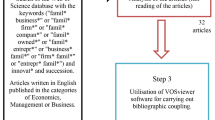Abstract
Through in-depth investigations and analyses of the Haier case, we enriched and developed further a new paradigm of innovation management—Total Innovation Management (TIM). The TIM framework and the synergistic relationship of the elements of innovation in the company’s innovation management are discussed along with the direction and routines for technological innovation management.










Similar content being viewed by others
References
Bean, R., & Radford, R. W. (2001). The business of innovation: Managing the corporate imagination for maximum results. AMACOM.
Christensen, C. M., & Overdorf, M. (2000). Meeting the challenge of disruptive change. Harvard Business Review, 78(2), 66–76.
Christiansen, J. A. (2000). Building the innovative organization. London, England: MacMillan.
Daveport, T. H. (1994). Process innovation. Boston, US: Harvard Business School Press.
Hammer, M., & Champy, J. (1993). Reengineering the corporation. HarperBusiness.
Iansiti, M. (1998). Technology intergration: Making critical choices in a dynamic world. Harvard Business School Press.
Jiang, H., & Chen, J. (2000). Integrated innovation: A new kind of innovation pattern. Research Management (in China), 5, 31–39.
Lu, Y. (2002). Towards the strategic requirement: Promote integrated innovation. Mechanical & Electronical Engineering Technology (in China) (1).
Nelson, R. R., & Winter, S. G. (1982). An evolutionary theory of economic change. Cambridge, MA: The Belknap Press of the Harvard University Press.
Schumpeter, J. A. (1942). Capitalism, socialism, and democracy. New York: Harper & Brothers.
Shapiro, S. M. (2002). 24/7 Innovation: A blueprint for surviving and thriving in an age of change. McGraw-Hill.
Tang, H. K. (1998). An integrative model of innovation in organizations. Technovation, 18(5), 297–309.
Tidd, J., Bessant, J., & Pavitt, K. (1997). Managing innovation: Integrating technological, market and organizational change. New York, US: John Wiley.
Tidd, J., Bessant, J. R., & Pavitt, K. (2001). Managing innovation: Integrating technological, market and organizational change. Chichester: John Wiley.
Tucker, R. B. (2002). Driving growth through innovation – How leading firms are transforming futures. Berrett-Koehler Publishers, Inc.
von Hippel, E. (1988). The sources of innovation. New York: Oxford University Press.
Wheatley, M. J. (2001). Leading for innovation: And organizing for results. Jossey-Bass.
Xu, Q. (2000). Management of research, development and technology-based innovation. Beijing, China: Higher Education Press.
Xu, Q., Guo, B., & Wang, Y. (1999). Development of technological innovation in China: Core competence-based innovation portfolio. PICMET’99, Oregon, USA.
Xu, Q., Zheng, G. et al. (2002). Towards capability-based Total Innovation Management (TIM): The emerging new trend of innovation management—acase study of Haier Group. ISMOT&ICMIT’02 Proceedings. Zhejiang Univ. Press.
Yi, J. J., & Ye, S. X. (2003). The Haier way—The making of a Chinese business leader and a global brand. Homa & Sekey Books.
Author information
Authors and Affiliations
Corresponding author
Additional information
This paper was under the project #70372018 supported by NSFC
Rights and permissions
About this article
Cite this article
Xu, Q., Zhu, L., Zheng, G. et al. Haier’s Tao of innovation: a case study of the emerging Total Innovation Management model. J Technol Transfer 32, 27–47 (2007). https://doi.org/10.1007/s10961-006-9008-9
Published:
Issue Date:
DOI: https://doi.org/10.1007/s10961-006-9008-9




